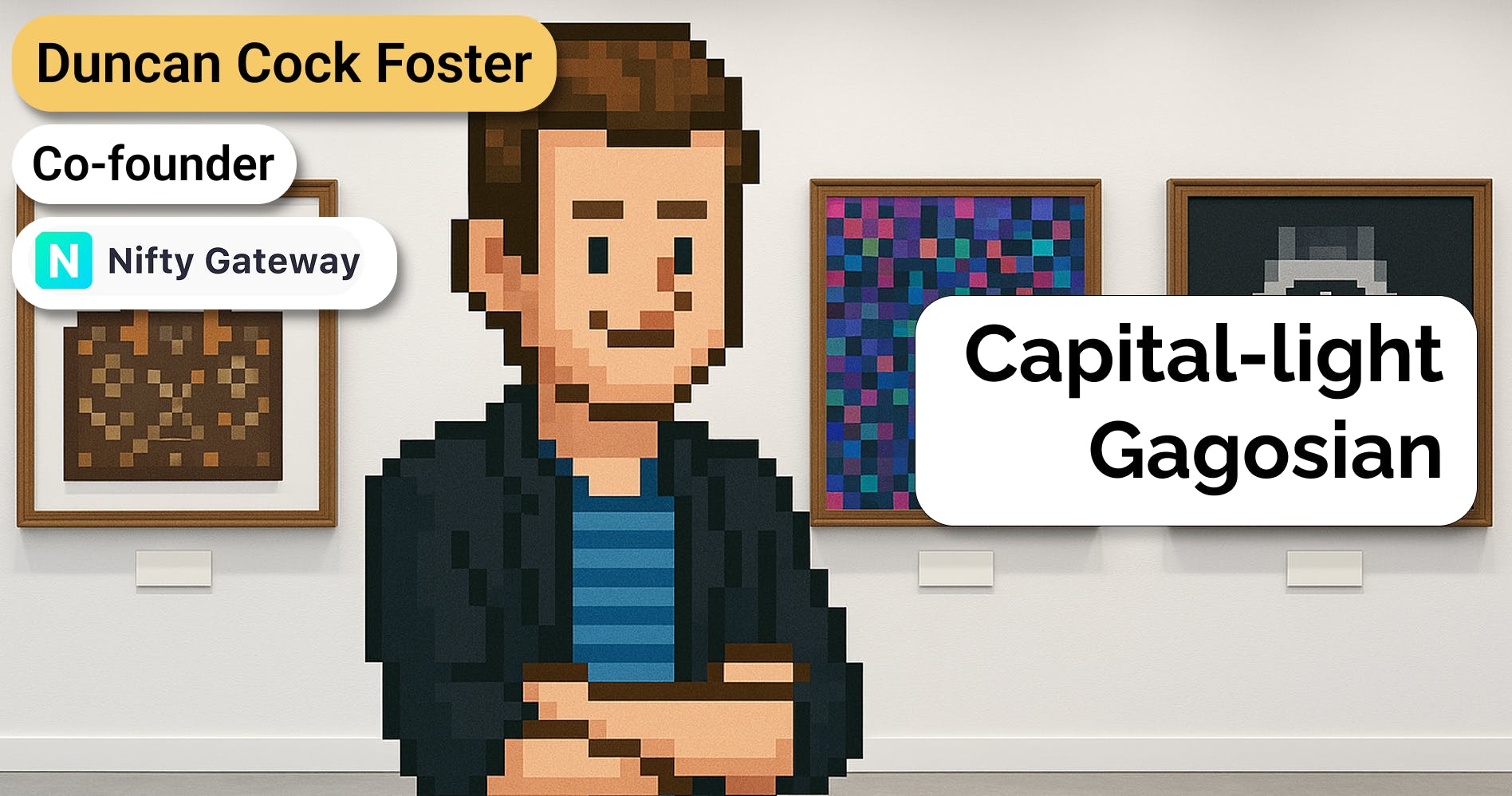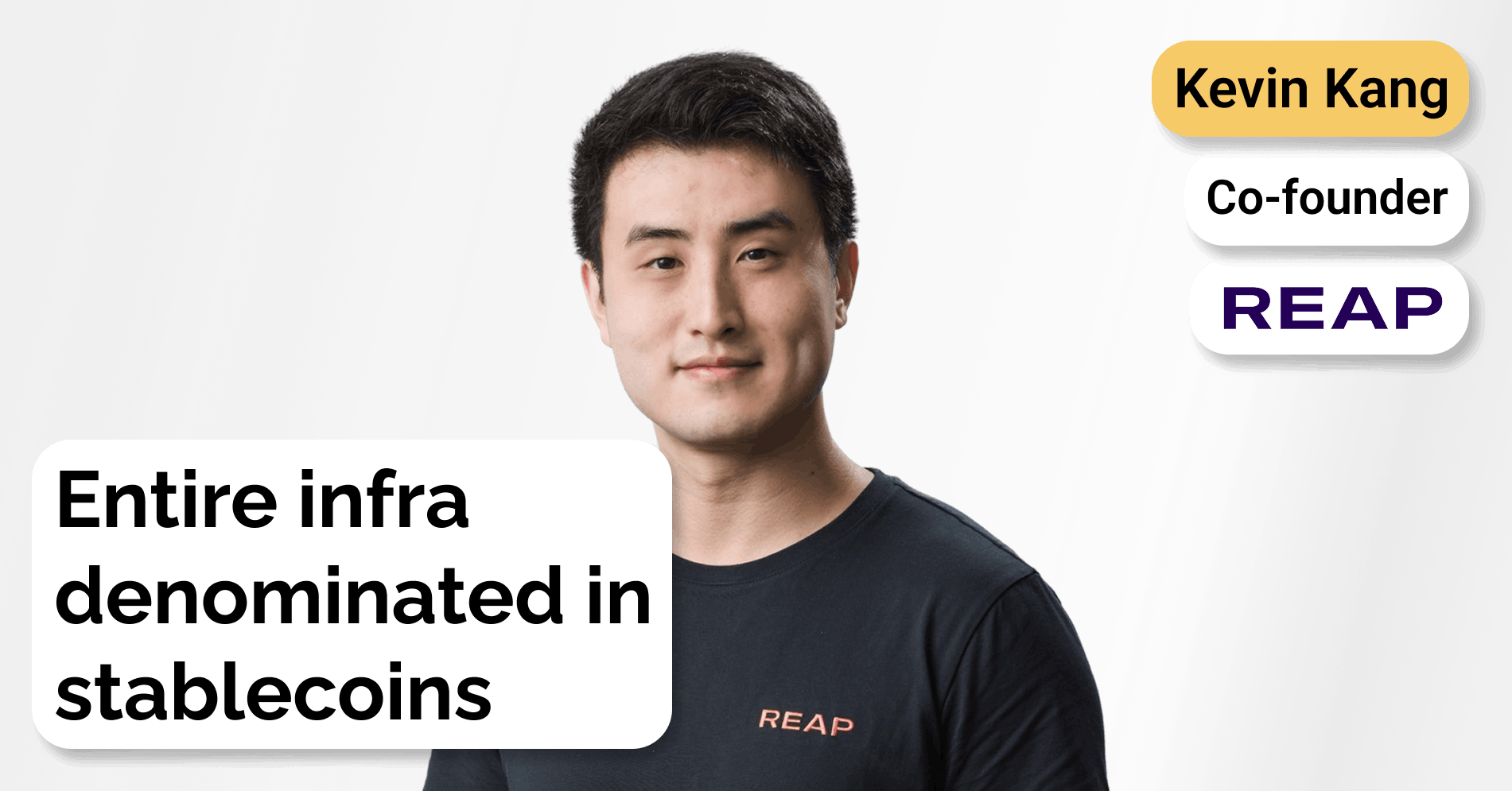Duncan Cock Foster, co-founder of Nifty Gateway, on NFTs as luxury goods
 Jan-Erik Asplund
Jan-Erik Asplund

Background
With the crash of the NFT market, OpenSea’s average weekly transaction volume dropped 98% from $1.4B in 2022 to less than $20M as of 2025.
The green shoots of a NFT spring are now emerging around the use case of programmable containers for luxury—digital objects engineered to be expensive and supply-constrained—mirroring the mechanics of fine art and other luxury goods. For more, check out our full interview with Nifty Gateway co-founder Duncan Cock Foster.
Key points from Sacra AI:
- The NFT market's collapse in 2022 marked the end of NFTs as financialized assets—bundled with equity-like upside, pseudo-membership rights, or meme coin appeal—and took down the generalist marketplaces built around that thesis, with OpenSea falling from 97% share in 2022 to 13% in 2024 as exchange-based NFT platforms from Coinbase and Kraken shuttered entirely. “It's really hard to bolt on an NFT marketplace to a crypto exchange because people come to a crypto exchange to buy tokens and investment assets, and the purchasing behavior for buying NFTs is very different…Even though these are both based on blockchain technology, the customer profile and buying psychology is very different… OpenSea and the generalist marketplaces are more of a broad-based index on a wide variety of NFT use cases. Their businesses depend on people trading NFTs as membership tokens, as pseudo-equity instruments, and a long list of other NFT types.”
- From the wreckage, luxury has held up as the enduring use case for NFTs, offering a programmable container for creating expensive & scarce digital objects—products like Louis Vuitton’s $40K “Treasure Trunks” and Hublot’s $60K NFT-paired watches that, like traditional luxury goods and fine art, derive value from controlled access & scarcity, high-quality craftsmanship & materials, heritage & provenance and cultural credibility as conferred by institutions like LACMA and MoMA. “[2022] was kind of a false start. A lot of the art institutions felt FOMO and rushed in to do it… Sotheby's and Christie's are transaction-based businesses who are trying to make more money like any business… LACMA and MoMA, because of their role as guardians of art history, have to become familiar with something in a much truer sense, and they have to feel that what they're doing is actually going to matter in the long term.”
- Specialized NFT platforms like Art Blocks and Nifty Gateway (acquired by Gemini) are evolving into high-margin, brand-driven curators of NFTs-as-digital-luxury-goods—with the potential upside of building capital-light Gagosians, capturing 5-10% commissions on large-scale sales without the real estate or overhead of traditional galleries. “A movie studio might be another useful analogy in the sense that there are these special one-off high-budget projects that are hit-driven. The successful ones gross a lot of money, and it's hard to know in advance which will be successful. At Nifty, a really large percentage of our revenue came from a very small number of projects that we worked on… [these companies can be] capital-light businesses with fantastic brands that can capture amazing profit dollars because of those brands, but don't have the cost of the physical footprints that galleries have.
Questions
- As someone who's been in the space, directly involved in Nifty Gateway until 2023, how do you see the conversation around NFTs has evolved?
- What's your take on why NFTs as meme coins, NFTs as equity stakes, NFTs as buying access to a golf course that will exist in the future - why did those not pan out the way that people saw it?
- To look at two big NFT projects—CryptoPunks and Bored Ape Yacht Club—where do you slot those in that dichotomy you pose, which is early crypto art focused versus more speculative? Are they more true to the nature of NFTs as art or somewhere in between?
- Was the original art for these programmatically generated?
- Historically, CryptoPunks and Bored Ape Yacht Club were about bragging rights and PFP flexing, but Twitter has even dropped the dedicated NFT profile picture feature. How has that affected the idea of NFTs as status symbols?
- We've seen big luxury names like LVMH experimenting with NFTs and major galleries like Gagosian dabbling in digital art. What do you make of these high-end, more traditional art or luxury players embracing NFTs?
- Can you say more about what distinguishes a LACMA or MoMA approach and in what sense they're engaging with the medium in a more considerate way versus a Sotheby's or Christie's?
- Generative AI is emerging as a major theme in NFT art creation. NFTs having this chain of provenance and being encoded on-chain feels like it maps really well to what AI artists are and will be doing.
- Was there any structural or infrastructure tool shift that made this the moment for the reemergence, or was it just a natural factor of it taking time for meaningful art to develop in any kind of ecosystem?
- Could you break down the different approaches we've seen from marketplaces—like OpenSea's generalist stance, Art Blocks' curated generative art, and Kraken's NFT platform? Are some of these models better positioned for where NFTs sit in 2025?
- If we take NFTs as luxury goods becoming the dominant use case for NFTs in the future, then what does the market look like? Are things like Art Blocks and Nifty Gateway more like Gagosian or more like Sotheby's and Christie's transfigured into the NFT ecosystem?
- I'm curious for your take on the physical luxury art market. I guess in 2024, things were slightly down with consumer demand. Do you see NFT art or Internet-enabled art eating into the larger fine art market that has been art and high-end collectibles, or is it kind of a part of that market?
- In the art market, you have this conflict between galleries on one end and artists who want to get more mass distribution on the other. How do you think about that side of NFT collecting? The prices on NFTs mostly aren't as high as gallery art, but do you see Art Blocks and Nifty Gateway being both high-end and for the masses? Is that just built into the concept of NFTs?
- I'm curious if there are any brands that you see positioning themselves well with respect to NFTs. There are a lot of brands that did NFT stuff during the boom, but do you think there's anyone doing that well now?
- Looking forward, let's say luxury goods are the core job to be done that wins with NFTs, and the other stuff doesn't come roaring back. What's the upside case or big vision for these specialized marketplaces that you're contending will win the market? What do they look like in five years if they're doing really well?
Interview
As someone who's been in the space, directly involved in Nifty Gateway until 2023, how do you see the conversation around NFTs has evolved?
I think the ambitions of the space have been scaled back. During the NFT boom in 2021, people were incredibly ambitious about the idea of NFTs revolutionizing a wide variety of industries and lost touch with reality as often happens in bubbles. Now the conversation around NFTs is more narrowly focused on NFTs as an improvement in a smaller set of industries - really more like digital art, collectibles, and luxury goods for the Internet.
In crypto, it's always very hard to separate the real from the noise. There's an incredible incentive for people to create noise around their narrative as a way to sell tokens, which makes it very hard to figure out what's actually a valuable use case and what actually has traction.
But if you look at NFTs in 2025, people are still buying NFTs as artwork and as luxury goods. The people who buy NFTs for the same reason they would buy a painting or a print from an artist they like have proved much stickier than the group who bought NFTs as a different type of meme coin or as some more ambitious idea like a new membership token. So right now in 2025, the industry is focused on a narrower set of use cases, but those use cases seem to have more substance and more longevity.
What's your take on why NFTs as meme coins, NFTs as equity stakes, NFTs as buying access to a golf course that will exist in the future - why did those not pan out the way that people saw it?
There are a few reasons. Number one, having an equity instrument that's not fungible is just a bad mechanic. If you're trying to create an equity instrument, it's much better to have it be fungible.
Number two, a lot of the membership token ideas didn't pan out because people who sell memberships need to sell them as recurring revenue. It's really hard to sell a membership that's a one-time pass that grants people unlimited lifetime access. A membership is really a commitment to pay money in an ongoing way to support people who produce content. So in many ways, NFTs were fundamentally flawed instruments for the things they were trying to do, and people discovered that pretty quickly.
Crypto has a dynamic where because the industry is so full of speculators, as soon as a crypto narrative takes off that isn't directly related to speculation, the speculators find out about it and dominate it.
I often compare the early days of NFTs to an underground art scene with a lot of cultural cache. People were collecting artists for the first time who had never been collected before. It was a worldwide artistic movement where people could sell art on the Internet directly - like a cool underground Brooklyn art scene. And then it's almost as if all the really rich collectors from Manhattan came in and overwhelmed the industry overnight because there was this flood of crypto money that is trained to see everything as a speculative instrument, and that had a strong distortive effect on the NFT industry in the early days.
To look at two big NFT projects—CryptoPunks and Bored Ape Yacht Club—where do you slot those in that dichotomy you pose, which is early crypto art focused versus more speculative? Are they more true to the nature of NFTs as art or somewhere in between?
I think CryptoPunks are 100% NFTs as art. It's not even ambiguous. They're universally accepted as status tokens from the early days of Ethereum, and they're seen in the same way that Bitcoin had its immaculate conception with Satoshi. They were given away for free in the beginning, and their cultural credentials are impeccable.
Bored Apes are slightly more complicated. There's a lot more debate around them. But in my opinion, I would also say that they're accepted as status symbols, as art pieces, as valuable collectibles more so than a speculative instrument. But Bored Apes are much more debated about, whereas with CryptoPunks, there's almost universal agreement in the community that they are works of art and not meme coins.
Personally, I would say Bored Apes are also works of art. It's just more debated.
Was the original art for these programmatically generated?
It was a mix. The most valuable NFT art - a lot of it is programmatically generated, and generative art is definitely one of the most successful offshoots to come out of the NFT movement. So it's a mix of programmatically generated and not programmatically generated.
There are some really valuable pieces that are programmatically generated, mostly from Art Blocks, which is the dominant player there. But then there are also a lot of artists who just create images and tokenize them on chain. XCOPY is probably the most famous example.
Historically, CryptoPunks and Bored Ape Yacht Club were about bragging rights and PFP flexing, but Twitter has even dropped the dedicated NFT profile picture feature. How has that affected the idea of NFTs as status symbols?
Without Twitter, the mechanism now is just sharing your wallet address or sharing a link to your collection. It is definitely harder to immediately ascertain what NFTs people have and what their collection looks like. You have to go to more specialized websites to do it.
But on the other hand, it's definitely easier than figuring out what someone's physical art collection looks like. To do that, you have to go to their house or their storage unit.
NFT profile pictures took off well before there was any verification mechanism, and it was just a social norm. It was really easy to verify if someone with a punk profile picture actually had a punk or not. It's almost like wearing a fake Rolex - you can make your profile picture a punk, but if someone figures out it's fake, that will really hurt your status. And it's much easier to figure out if the NFT is fake versus the Rolex.
We've seen big luxury names like LVMH experimenting with NFTs and major galleries like Gagosian dabbling in digital art. What do you make of these high-end, more traditional art or luxury players embracing NFTs?
I think a lot of the institutions of the art world are businesses like any other, and they tend to go where the money is. That's especially true of Sotheby's and Christie's who view themselves as auction houses for any type of collectible that people will buy.
I think it was kind of a false start - a lot of the art institutions felt FOMO and rushed in to do it. They didn't really engage with NFTs in an authentic or sustainable way, and now a lot of them are withdrawing. I think a more sustainable foundation is being laid now, and the art institutions that are acquiring NFTs, especially museums like LACMA and MoMA, are doing it in a way where they actually understand and appreciate the medium, which is much more sustainable for the long term.
So I think the story will continue to be short-term retrenchment. But in the medium to long term, the number of institutions that actually get it and appreciate NFTs as an art medium will continue to grow. The MoMA just acquired their first NFT last year, for example.
The art world is extremely conservative and very slow-moving by design. One of the bad assumptions of the NFT bubble of 2021 was that you could certify artists as historically important in a year and a half, when it takes a decade minimum. A decade is a very fast period of time to do it. If you look at the artists who have been considered most impactful historically, it's often much longer than a decade for them to be recognized. So it's going to be a slow and steady process, but there are definitely positive signs, like MoMA acquiring their first NFT and LACMA being a great example of an institution that's forward-looking and actually understands NFTs as a medium.
Can you say more about what distinguishes a LACMA or MoMA approach and in what sense they're engaging with the medium in a more considerate way versus a Sotheby's or Christie's?
I don't want to bash Sotheby's and Christie's too much. They simply have very different roles in the ecosystem.
LACMA and MoMA are guardians of art history - their job is to certify what is part of art history and what is not. They're not businesses; they're nonprofits. Sotheby's and Christie's are transaction-based businesses who are trying to make more money like any business. They don't have to be true believers in what they sell in order to sell it.
They've also done streetwear auctions and sneaker auctions, and I'm sure the number of sneakerheads who work at Sotheby's is pretty low. For them, they don't have to be true believers in something in order to adopt it. Whereas LACMA and MoMA, because of their role as guardians of art history, have to become familiar with something in a much truer sense, and they have to feel that what they're doing is actually going to matter in the long term.
What you see from those institutions is that they actually take the time to understand why NFTs are interesting from an artistic perspective and the new things that are available to artists in the NFT medium that were not available before.
Generative art and Art Blocks is probably the simplest example to understand. Art Blocks with generative art where the parameters are encoded on chain is simply not something that could be created before. NFTs as an artistic medium are defined by the works that people create in the medium. As those works use the medium better and get more artistically interesting, I think they'll be recognized by more institutions.
Generative AI is emerging as a major theme in NFT art creation. NFTs having this chain of provenance and being encoded on-chain feels like it maps really well to what AI artists are and will be doing.
I like to think of NFTs as the artistic medium of the Internet because what they enable people to do is create technologically enabled and Internet-enabled art in a way that wasn't possible before.
People can create art projects that live natively online, and anyone can participate in an Internet-enabled way that just isn't possible with physical art. For example, the release Sam Spratt just did on Nifty Gateway a few months ago is a good example of this. You buy an NFT, and then you leave a comment on the painting itself. It's like one giant artwork where buying an NFT means you have to leave a comment on the painting, and that comment also gets tokenized. It's this large Internet-scale participatory thing that isn't really possible except in the NFT medium.
That release did over $5 million in sales even though NFTs have completely fallen off everyone's radar, which to me is a perfect example of how the true collector crowd has proven much stickier than the ephemeral meme coin crowd.
I always like to compare NFTs to movies - a technology-enabled artistic medium that takes a really long time for people to figure out how to use well. Over time, as they figure out how to use them well, you start to see people do things in the new medium that couldn't exist in the old medium. And then they start to be recognized as artistically valid. I feel like NFTs are playing out that cycle, and people just had an expectation that it could happen in a very short period of time. But almost by definition, it can't. It has to happen over a longer period of time.
Was there any structural or infrastructure tool shift that made this the moment for the reemergence, or was it just a natural factor of it taking time for meaningful art to develop in any kind of ecosystem?
I think it's more of the latter, but I'm sure there are probably some tools out there I haven't thought about. There's also just a process of NFT technology and user experiences improving. The crypto industry as a whole has gotten much better. Transactions have gotten much cheaper and faster, and that is definitely a tailwind for the NFT industry.
As crypto technology improves, it's sort of like the way camera technology improving pushes forward the movie industry. It increases what you can do and gives you more opportunity to create interesting art projects. But I can't point to a specific development that has enabled the reemergence. I think it's probably more the latter - just the process that takes time for the sorting, for the real things to rise to the top.
Could you break down the different approaches we've seen from marketplaces—like OpenSea's generalist stance, Art Blocks' curated generative art, and Kraken's NFT platform? Are some of these models better positioned for where NFTs sit in 2025?
I think it's proved really challenging for exchanges to add on NFT marketplaces. Coinbase NFT is the most notable example of an NFT marketplace that had a ton of excitement and hype. I think they even projected a huge revenue number for their NFT marketplace in one of their earnings reports.
It's really hard to bolt on an NFT marketplace to a crypto exchange because people come to a crypto exchange to buy tokens and investment assets, and the purchasing behavior for buying NFTs is very different. Gemini is probably the exchange that has made the most money from selling NFTs, and the reason is that they didn't treat selling NFTs like another token. They treated it as its own experience - Nifty Gateway was a totally separate website, and NFTs were sold much more as art than as another token on the list that Gemini sells.
It was kind of a misreading of the movement. Even though these are both based on blockchain technology, the customer profile and buying psychology is very different. That's why it's proved hard for exchanges to bolt on NFT marketplaces.
Personally, I'm more bullish on the dedicated specialized marketplaces like Art Blocks and Nifty Gateway. I think those businesses will generate more profit dollars because the part of NFTs that seems to have real longevity is NFTs as luxury items and as art.
OpenSea and the generalist marketplaces are more of a broad-based index on a wide variety of NFT use cases. Their businesses depend on people trading NFTs as membership tokens, as pseudo-equity instruments, and a long list of other NFT types.
If the current trend continues and growth in the NFT industry comes from NFTs as luxury goods versus a wide variety of use cases, then the specialized marketplaces are in a better position. The NFT industry will look more like the art industry where the people who make money are really on the inside - they make money by selling high-value specialized NFTs as opposed to being broad market indexes.
But if we do see a resurgence in more NFT use cases like passes, if PFPs make a roaring comeback, if there is another round of speculative meme coin-esque media for NFTs, then the broad-based marketplaces like OpenSea will be really well positioned.
I think OpenSea is struggling to find its purpose and direction right now. The vampire attack from Blur - they almost never recovered psychologically from it, and they also had to deal with a huge downturn in the NFT industry at the same time. But as far as I know, they still have the largest number of daily active users and NFT collectors who visit their website. So if there's another NFT wave that looks exactly like the 2021 NFT wave, OpenSea would be very well positioned. If instead it's more of a growth of NFTs as luxury goods and art, then OpenSea's decline will probably continue, and they'll probably not really be able to find their place in the ecosystem.
If we take NFTs as luxury goods becoming the dominant use case for NFTs in the future, then what does the market look like? Are things like Art Blocks and Nifty Gateway more like Gagosian or more like Sotheby's and Christie's transfigured into the NFT ecosystem?
They're definitely more like Gagosian. The Sam Spratt drop that Nifty just did took multiple months to produce. It did sell over $5 million, but it was an incredible amount of work to put together. Those two things are very intertwined - a real reason that people liked the drop so much and bought so much from it was because it was so well executed, with so much vision and taste behind it, which looks much more like a Gagosian exhibit than a Sotheby's auction.
A movie studio might be another useful analogy in the sense that there are these special one-off high-budget projects that are hit-driven. The successful ones gross a lot of money, and it's hard to know in advance which will be successful. At Nifty, a really large percentage of our revenue came from a very small number of projects that we worked on. We really did have a hit-driven business.
I'm sure Art Blocks is probably similar. Fidenzas probably drives a huge amount of their revenue and attention relative to everything else.
I'm curious for your take on the physical luxury art market. I guess in 2024, things were slightly down with consumer demand. Do you see NFT art or Internet-enabled art eating into the larger fine art market that has been art and high-end collectibles, or is it kind of a part of that market?
I actually think that they're very correlated even now. The physical art market is also really suffering. The physical art market downturn is for roughly the same reason that the rest of the luxury downturn is happening - they raised prices too much during the bubble years of 2021-2022. Luxury industries find it very difficult to lower prices. When you're in boom times, there's always a temptation to crank up prices to the maximum, but that comes back to bite you once the boom time ends.
Art galleries have it even tougher because unlike Rolex or Hermès, who have complete pricing power over what they sell, galleries have 50-100 different artists they have to deal with. They have to price each artist individually, which is essentially more complicated.
I actually think NFTs and physical art are already pretty correlated. I don't think that NFTs will eat into physical art very much - I think it'll be more additive. We saw a lot of collectors on Nifty Gateway who had never collected physical art before. They got into NFTs, and then a lot of them bought physical art after that.
We saw the opposite pattern as well, where physical art collectors started buying NFTs, but they didn't stop buying physical art. They bought both. I think that's much more likely to happen - it's not a substitution, it's a complement.
If you're into collecting art specifically, you're going to want to collect the artists you love and the stuff that really speaks to you. It's unlikely that only NFTs or only physical art will speak to you - it's much more likely that you'll appreciate works in both mediums.
There could be a generational shift here as well. The average physical art collector is something like 58, whereas the average NFT art collector is much younger. It could be the case that in thirty years, NFTs really have meaningfully eaten into the physical art market share, but that would not be my prediction.
In the art market, you have this conflict between galleries on one end and artists who want to get more mass distribution on the other. How do you think about that side of NFT collecting? The prices on NFTs mostly aren't as high as gallery art, but do you see Art Blocks and Nifty Gateway being both high-end and for the masses? Is that just built into the concept of NFTs?
That's a great question. I'm really not sure how this will play out, and I think it's actually one of the more difficult aspects of NFTs. Because NFTs are Internet native, they lend themselves to abundance. There's no marginal cost to produce a thousand NFT editions versus a hundred.
That dynamic meant that open editions always drove a ton of sales for us at Nifty and were one of the more successful release mechanisms for NFTs. It also means you can create these large-scale participatory projects - if 10 people own an edition of your artwork, there are only 10 people tweeting about it. If 10,000 people own it and they're all excited about it, there are 10,000 people tweeting about it.
That's a fundamental aspect of NFTs. Because they're Internet native with no marginal cost of production, it lends itself to large edition sizes that are less expensive.
At the same time, the laws of luxury haven't gone away - there are countless examples of artists who have done too many open editions and tarnished their brands with people who would buy expensive one-of-ones from them. So it's an unresolved conflict in the NFT world, and we don't really have a sense of how exactly this will play out.
Damien Hirst is an example of an artist who somehow manages to sell gallery-level art but also print-level art, and he does it seamlessly. It has never hurt the demand for his art. I don't know how exactly he pulled it off. It seems like the best artists can pull it off, but it's really hard if you're more of a mid-tier artist and not as established as Damien Hirst.
In the NFT world, XCOPY is a good example of this too. He sold open editions at very high edition sizes, and he's sold really expensive one-of-ones. Those two things don't seem to impact each other - there's demand for his one-of-ones and demand for his large-scale editions. So he's sort of like the Damien Hirst of NFT land in that regard.
I have no idea how this will play out, and it's one of the more difficult aspects of running an NFT marketplace of any kind.
I'm curious if there are any brands that you see positioning themselves well with respect to NFTs. There are a lot of brands that did NFT stuff during the boom, but do you think there's anyone doing that well now?
LACMA comes to mind. I mentioned them earlier. I think LVMH is doing it well also in the sense that their understanding is better than average, and they're plugged in. They would be well positioned if there's a major renaissance.
Those are really the main two that come to mind. But they're really doing well in terms of preparation rather than actual execution right now. If NFTs do come back, they'll be well set up to capitalize on it.
Looking forward, let's say luxury goods are the core job to be done that wins with NFTs, and the other stuff doesn't come roaring back. What's the upside case or big vision for these specialized marketplaces that you're contending will win the market? What do they look like in five years if they're doing really well?
I think they look like Gagosian without 16 leases in really expensive real estate markets - capital-light businesses with fantastic brands that can capture amazing profit dollars because of those brands, but don't have the cost of the physical footprints that galleries have.
Because NFTs are an Internet native medium, it's hard to predict. Physical art is $65 billion a year. NFTs being Internet native means they can scale much faster than physical art.
I think video games is the right analogy here. Video games ended up so much bigger than board games, or movies ended up so much larger than plays because they were so much easier to distribute. NFTs are far easier to distribute than physical art. So the bull case is that the ease of distribution means these strongly branded luxury Internet-native galleries end up with a larger market and a much better cost structure than physical art galleries.
The real challenge is that many people just don't see the value in collecting NFTs, and that includes many physical art collectors. But the number of people who do see the value and are willing to pay for an NFT is quite high. The median person would probably still say about NFTs, "Why would I buy that when I can just download the image?" But again, the median person would also say, "Why would I pay a million dollars for a painting?" The median person doesn't understand physical art collecting either. So I don't know how much that actually matters.
Disclaimers
This transcript is for information purposes only and does not constitute advice of any type or trade recommendation and should not form the basis of any investment decision. Sacra accepts no liability for the transcript or for any errors, omissions or inaccuracies in respect of it. The views of the experts expressed in the transcript are those of the experts and they are not endorsed by, nor do they represent the opinion of Sacra. Sacra reserves all copyright, intellectual property rights in the transcript. Any modification, copying, displaying, distributing, transmitting, publishing, licensing, creating derivative works from, or selling any transcript is strictly prohibited.




